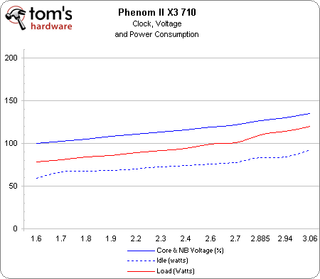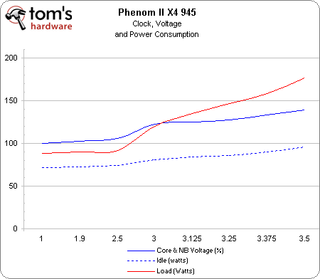Updated: Tuning Cool'n'Quiet: Maximize Power And Performance
Voltage Ramp And Power Consumption, Continued
Phenom II X3 710

| Clock | Core and Northbridge Voltage | Idle | Load |
|---|---|---|---|
| 1.6 GHz | 0.925V | 59 watts | 78 watts |
| 1.7 GHz | 0.950V | 67 watts | 81 watts |
| 1.8 GHz | 0.975V | 68 watts | 84 watts |
| 1.9 GHz | 1.000V | 68 watts | 86 watts |
| 2.2 GHz | 1.035V | 70 watts | 89 watts |
| 2.3 GHz | 1.050V | 72 watts | 92 watts |
| 2.4 GHz | 1.075V | 74 watts | 94 watts |
| 2.6 GHz | 1.100V | 76 watts | 99 watts |
| 2.7 GHz | 1.125V | 78 watts | 101 watts |
| 2.885 GHz | 1.175V | 83 watts | 110 watts |
| 2.940 GHz | 1.200V | 84 watts | 114 watts |
| 3.060 GHz | 1.250V | 92 watts | 120 watts |
Just a reminder: we had to overclock the HT bus to 245 MHz (though we'd lock the multiplier at 7x) to get above 2.6 GHz. This processor is not a Black Edition model. The resulting clock rate increase is not gradual; this would explain the relatively greater rise is power consumption when going from 2.7 GHz to 2.895 GHz.
Unlike the Athlon X2 7750, we're not seeing any “free MHz” here. If you want to push power consumption as low as possible, 1.6 GHz is the only choice. This should be the lowest idle p-state, if possible. You can choose 1.7 GHz and 2.2 GHz as intermediate p-states, with the performance p-state set at 2.6 GHz.
If you're into overclocking, 3.06 GHz still makes sense. You don't even have to change p-states settings (except for voltages). The intermediary and idle p-states are already optimal (2.327 GHz, 1.715 GHz, and 980 MHz).
Let's compare these numbers with the default settings. At 3.06 GHz, we can still get about the same level of load power consumption. After all, we're still using the same voltage. However, idle power consumption is higher by about 10 watts (92 versus 81 watts). That difference stays the same if we choose 2.7 GHz @ 1.15V as the idle p-state.
Phenom II X4 945

| Clock | Core and Northbridge Voltage | Idle | Load |
|---|---|---|---|
| 1 GHz | 0.900V | 72 watts | 88 watts |
| 1.9 GHz | 0.925V | 73 watts | 90 watts |
| 2.5 GHz | 0.950V | 74 watts | 92 watts |
| 3 GHz | 1.100V | 80 watts | 120 watts |
| 3.13 GHz | 1.125V | 85 watts | 137 watts |
| 3.25 GHz | 1.150V | 86 watts | 145 watts |
| 3.38 GHz | 1.200V | 90 watts | 158 watts |
| 3.5 GHz | 1.250V | 96 watts | 177 watts |
As with the Phenom II X3 710, we had to overclock the HyperTransport interconnect to 250 MHz to get above 3 GHz; this is not a Black Edition processor. Hitting power consumption levels below 70 watts is not possible (yet) with the Gigabyte GA-MA790GP-DS4H. With that in mind, 1.9 GHz seems to be the best choice for the idle p-state, or at least the second intermediary p-state. The first intermediary p-state can be set at 2.5 GHz with the performance p-state at 3 GHz.
Stay on the Cutting Edge
Join the experts who read Tom's Hardware for the inside track on enthusiast PC tech news — and have for over 25 years. We'll send breaking news and in-depth reviews of CPUs, GPUs, AI, maker hardware and more straight to your inbox.
We were unable to reach stability above 3.5 GHz, even at 1.35V. So, the highest setting we're using is what we can achieve with 1.25V (3.5 GHz). This setting isn't really ideal from a power consumption point of view, since the increase in voltage causes power consumption to jump. The optimal setting is really just 3 GHz, the default clock rate for this processor. If you're overclocking, you might get away with 3.25 GHz, since the difference is minor (5 to 10 watts).
With the GA-MA790GP-DS4H, we didn't have to boost voltages for lower p-states when overclocked. That means you can use 2.5 GHz and 3 GHz for intermediary p-states, with 2 GHz as the idle p-state and 3.5 GHz as the performance p-state. Idle power consumption is about the same when you overclock with this motherboard.
Since we're using almost the same voltage at 3.5 GHz (1.25/1.25V compared to the default 1.35/1.1V), we were able to get slightly lower power consumption numbers than default (96/177 watts at 3.5 GHz compared to 103/177 watts at 3 GHz). At 1.15V we can still hit 3.125 GHz. If you want to maintain idle power consumption, use 2.5 GHz @ 0.95V. Compare that setting to the default, 800 MHz to 2.5 GHz. That's quite a bit of difference.
Current page: Voltage Ramp And Power Consumption, Continued
Prev Page Voltage Ramp And Power Consumption Next Page Phenom X4 955 And Conclusion-
DrgnRebrn Nice article! I'm curious to know if the "e" CPUs can be affected in the same way, such as the Phenom II X3 705e. I have chosen this CPU for a HTPC build because of it's already low 65W TDP. Also, what are the effect to power usage when using ACC features & enabling dormant cores?Reply -
cyberkuberiah On the behalf of all readers , Welcome , and so to say , Hi! , Arnawa Widagda :)Reply -
Very good article! Undervolting it's a great tweak to make and most of the people don't even know that it is possible as well as overvolting, getting a power efficient processor for no money! Thanks tom's for caring about this matter.Reply
-
autoimmune Inf3rnalI'd like to see same article about Intel i5/i7 power setting tweaking. O my GOD i bet the writers at Toms Hardware had not thought of that, and are not currently in the process of writing that article!Reply
-
i love you guys. i have just the system that i am using as HTPC. i was wondering about ways to reduce the power usage as i dont use it for hardcore gaming or any other cpu intensive jobs. all i use it for watching blurays and tv and other movies and songs. i have an ASROCK 790gxh 128M mobo. and 1thlon x2 7750 kuma, that i bought from newegg for $59 (darn steal for the performance it gives. the machine has almost zero latency for any operation)Reply
Most Popular

